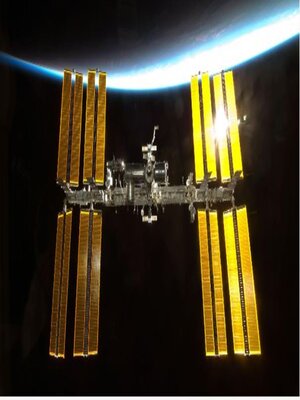
Sign up to save your library
With an OverDrive account, you can save your favorite libraries for at-a-glance information about availability. Find out more about OverDrive accounts.
Find this title in Libby, the library reading app by OverDrive.



Search for a digital library with this title
Title found at these libraries:
| Library Name | Distance |
|---|---|
| Loading... |
The International Space Station (ISS) is a large, habitable spacecraft that orbits Earth and serves as a unique laboratory for scientific research, technology testing, and international cooperation in space. Here's a comprehensive overview:
Overview
Orbit: Low Earth Orbit (LEO), approximately 400 km (250 miles) above Earth.
Speed: Travels at ~28,000 km/h (17,500 mph), completing an orbit roughly every 90 minutes.
Size: About the size of a football field (109 meters end to end).
Weight: Over 420,000 kilograms (925,000 pounds).
Construction and Ownership
Launched: First module (Zarya) launched on November 20, 1998.
Construction: Assembled piece-by-piece in orbit by multiple missions.
Partners:
NASA (United States)
Roscosmos (Russia)
ESA (European Space Agency)
JAXA (Japan Aerospace Exploration Agency)
CSA (Canadian Space Agency)
Ownership is based on international agreements. Modules belong to different space agencies, but the ISS is operated as a unified laboratory.
Structure
Modules: Includes laboratories (U.S. Destiny, European Columbus, Japanese Kibo), crew quarters, storage, and docking ports.
Solar Arrays: Provide power; among the largest ever deployed in space.
Robotic Arms: Such as Canada's Canadarm2, used for maintenance and assisting docking.
Crew and Life Aboard
Capacity: Normally hosts 6–7 astronauts from different countries.
Duration: Astronauts typically stay for 6 months, with some longer missions.
Daily Life:
Conducting experiments in microgravity.
Exercising (2+ hours/day to counteract bone/muscle loss).
Maintaining systems and communicating with Earth.
Scientific Research
ISS is a platform for research in:
Biology and human physiology
Fluid dynamics
Materials science
Space medicine
Astrobiology
Earth and space observation
Experiments performed here help develop technologies for future missions to the Moon and Mars.
Commercial and Educational Role
Commercial cargo and crew services (e.g., SpaceX Dragon, Boeing Starliner).
Used for outreach and education globally, with live video feeds and classroom interactions.
A testbed for private enterprise in low Earth orbit.
Future of the ISS
Lifespan: Originally planned to operate until 2020, but extended several times; currently funded through 2030.
Post-ISS Plans:
NASA and partners plan for commercial space stations (e.g., Axiom Station).
Russia and China have discussed their own independent space stations.
🔹 Fun Facts
Visible to the naked eye from Earth as a bright, fast-moving star.
Over 260 astronauts from 20+ countries have visited.
It has traveled billions of kilometers, orbiting Earth more than 100,000 times.







